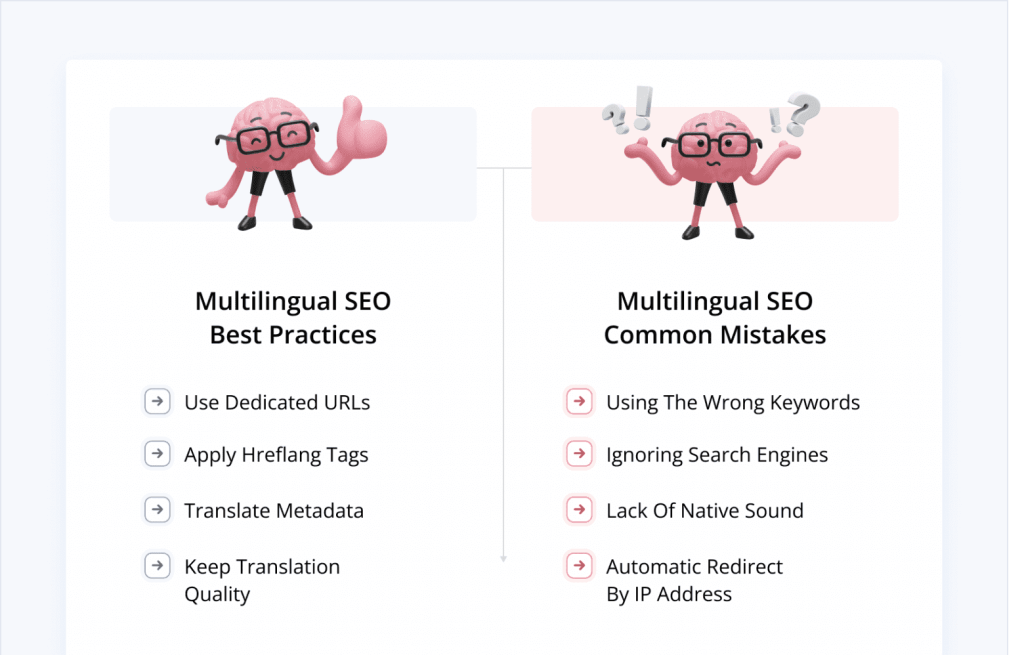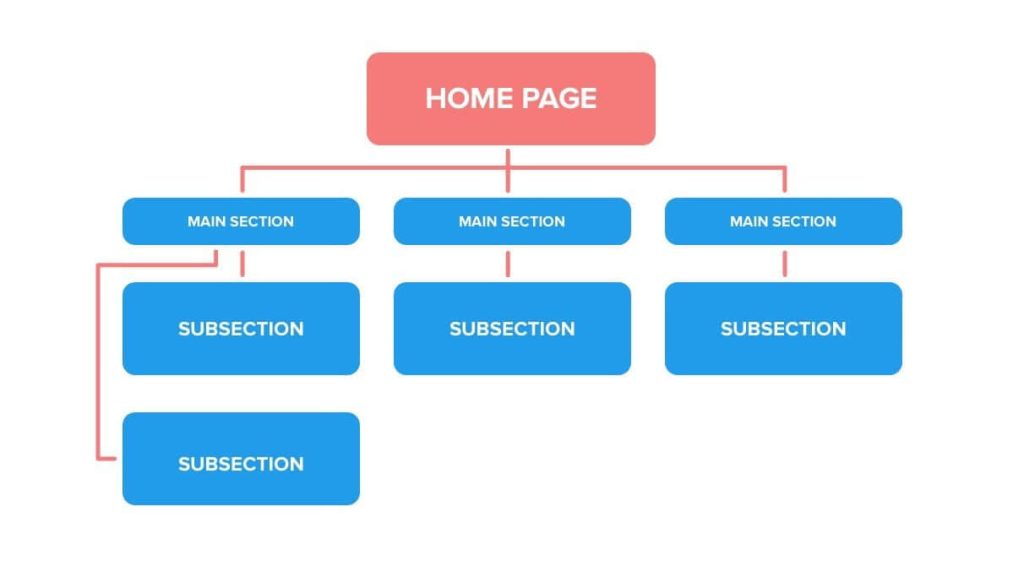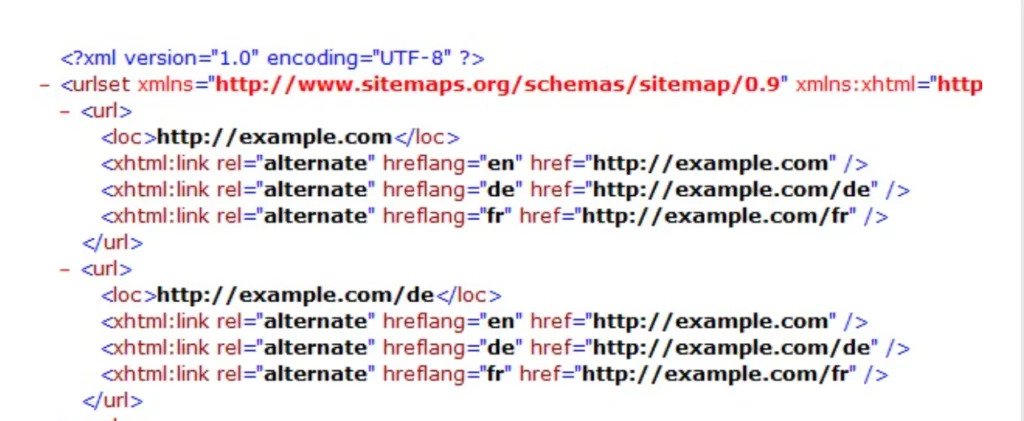What if your ideal customers cannot read in English ? How can you reach them digitally? Multilingual SEO technique is used to convert website content in multiple languages.
It helps the users find the website in their local language in organic search results. It makes the content accessible in their native language.
This blog post provides a comprehensive overview of multilingual SEO. It covers key components, challenges, and best practices.
We will start by defining multilingual SEO and explaining its importance for businesses. We will then delve into the key components of multilingual SEO, including keyword research, content creation, and on-page optimization.
Next, we have discussed the challenges of multilingual SEO. Such as, linguistic and technical issues, and offer solutions to overcome them.
Finally, we have covered best practices for implementing multilingual SEO. Alongwith conducting market analysis, optimizing website structure and navigation, and implementing hreflang tags.
By the end of this read you will have knowledge about multilingual seo. You can have command on it and how can you implement it in your business.
Highlights of the Multilingual SEO are:
– Multilingual SEO involves optimizing a website for multiple languages and targeting different countries or regions.
– Multilingual SEO is important for businesses as it provides access to global markets, enhances user experience, and improves search engine rankings.
– The key components of multilingual SEO include keyword research, content creation, and on-page optimization.
– Linguistic and technical challenges, such as differences in language structure and grammar, cultural differences, and technical implementation of hreflang tags, can affect the effectiveness of a multilingual SEO strategy.
– Best practices for multilingual SEO include conducting thorough market analysis, optimizing website structure and navigation, and implementing hreflang tags correctly.
What is Multilingual SEO?
The practice of optimizing a website for multiple languages is referred to as multilingual SEO. It is applied to target different countries or regions.
It involves adapting content, keywords, and other website elements to cater to the language and cultural preferences of different audiences.

Importance of Multilingual SEO for Businesses
- Access to global markets: Multilingual SEO allows businesses to target international markets and reach a broader audience.
- Increased website traffic: Businesses can attract more visitors to their website, by optimizing for multiple languages. Increasing conversions and income as a result.
- Enhanced user experience: A website optimized for multiple languages is user friendly. Especially those who like to browse in their native language.
- Competitive advantage: Businesses that invest in multilingual SEO have a competitive advantage. They are better positioned to tap into global markets and connect with customers from diverse cultures.
What is SEO?
When a website is optimized for search engines, it is said to be “SEO optimized”. It improves websites visibility and ranking on search engine results pages (SERPs). By utilizing SEO services, businesses can maximize their online presence and acquire more traffic, leads, and customers.

The aim is to increase organic traffic and improve the website’s performance in terms of search engine rankings. SEO involves various techniques and strategies, like keyword research and on-page optimization. Content creation, link building techniques are also used to improve websites ranking.
In the eyes of search engines SEO improves the website’s relevance, authority, and credibility. The ultimate use of it is to increase the website’s visibility and attract more visitors, leads, and sales.
Key Components of Multilingual SEO
Some of the key component of the multilingual SEO that are vital are:
Keyword Research and Analysis:
Keyword research is an essential component of multilingual SEO. The process begins with the selection of the best possible set of keywords and phrases. It helps you target your ideal customer from different regions.

With keyword research in different languages you can identify the most effective keywords. And optimize your content and website accordingly Increase your visibility in search engine results pages (SERPs) with this technique.
Tools for Multilingual Keyword Research
There are several tools available for multilingual keyword research, including:
- Google Keyword Planner: This tool provides keyword ideas and traffic estimates based on your website and target locations. It also allows you to filter keywords by language.
- SEMrush: SEMrush is a comprehensive SEO tool that offers multilingual keyword research features. It provides insights into competitors’ keywords, search volume, and difficulty, making it easier to find and target relevant keywords.
- Ahrefs: Ahrefs is another popular SEO tool that offers multilingual keyword research features. It provides data on search volume, keyword difficulty, and more, helping you identify the most effective keywords for your website.
Content Creation
Creating high-quality, relevant content is important for multilingual SEO. Search engines ranks content higher that is informative, engaging, and valuable to users.
Create quality content in multiple languages to increase your website’s relevance and authority. It also leads to better search engine rankings, increased traffic, and better user engagement.
Best Practices for Creating Multilingual Content
Following are best practices in creating effective multilingual content :
- Understand your Audience: Conduct thorough market research to understand the language and cultural preferences of your target audience. This practice enable you to customize your content according to your needs.
- Use Professional Translators: Avoid using machine translation tools and opt for professional translators who are fluent in both the source and target languages. This ensures accuracy, cultural sensitivity, and clarity of your content.
- Localize your Content: Localize your content by adapting it to the local culture, including idioms, expressions, and cultural references. In turn, this increases your audience’s confidence in you.
- Optimize for Keywords: Conduct multilingual keyword research and optimize your content accordingly. Use relevant keywords in your titles, headings, and body text to improve your visibility in SERPs.
- Ensure Consistency: Maintain consistency across all versions of your content, including language, tone, and style. You can build trust and credibility with your audience using this practice.
On-Page Optimization:
On-page optimization is an essential aspect of multilingual SEO as it involves optimizing various elements of your website to make it easier for search engines to crawl and understand your content. By optimizing your multilingual website, you can improve your website’s performance in search engine rankings and provide a better user experience to your audience.

Best practices for Multilingual On-Page Optimization:
By implementing these best practices, you can optimize your multilingual website for search engines and provide a better user experience for your audience.
- Use Hreflang Tags: Implement hreflang tags to inform search engines about the language and regional targeting of your content. This helps ensure that search engines serve the correct version of your content to the appropriate audience.
- Use Language-Specific URLs: Use language-specific URLs that are easy to understand and identify. This can improve the user experience and make it easier for search engines to understand the content of each page.
- Use Language-Specific Meta Tags: Use language-specific meta tags, such as title tags and meta descriptions, to provide relevant information about your content to search engines.
- Optimize Images and Multimedia: Optimize images and multimedia for each language version of your website. Use alt tags, captions, and other descriptive elements to make it easier for search engines to understand your content.
- Ensure Website Speed and Mobile Responsiveness: Ensure that your website is fast and mobile-responsive for all language versions. This improves the user experience and can lead to better search engine rankings.
Challenges of Multilingual SEO
By addressing these challenges, you can improve the effectiveness of your multilingual SEO strategy and increase your website’s visibility and traffic across multiple languages and regions.
Linguistic Challenges:
Differences in Language Structure and Grammar:
Different languages have varying structures and grammar rules that can affect keyword research, content creation, and on-page optimization. It is essential to understand these differences and tailor your approach accordingly.
Cultural Differences in Language Usage:
Cultural nuances can have a significant impact on the effectiveness of your multilingual SEO strategy. Keyword research, content development, and on-page SEO may all be impacted by cultural variances in language use. It is important to consider cultural differences and adapt your strategy accordingly.
Technical Challenges:
Implementing Hreflang Tags:
Implementing hreflang tags can be challenging, particularly for large websites with many pages and language versions. Incorrect implementation can lead to misinterpretation by search engines, resulting in lower search engine rankings and traffic.
Dealing with Duplicate Content:
Multilingual websites often have duplicate content across different language versions. This can lead to penalties from search engines, resulting in lower search engine rankings and traffic. It is important to use canonical tags, hreflang tags, and other techniques to manage duplicate content effectively.
Best Practices for Multilingual SEO
By conducting a thorough analysis of your target markets and languages, you can select the most effective languages for your multilingual SEO strategy and tailor your approach to meet the needs and preferences of your audience.

Conduct a thorough analysis of target markets and languages:
- Importance of market analysis: Before embarking on a multilingual SEO strategy, it is essential to conduct a thorough analysis of your target markets and languages. This will help you understand the language preferences, search behavior, and cultural nuances of your audience. By conducting market analysis, you can tailor your multilingual SEO strategy to meet the needs and preferences of your target audience, leading to better search engine rankings, increased traffic, and better user engagement.
- Tips for language selection: When selecting languages for your multilingual SEO strategy, consider the following tips:
- Conduct market research to identify the most commonly spoken languages in your target markets.
- Consider the search behavior of your audience and target languages that are commonly used in search queries.
- Analyze the competition to identify which languages your competitors are targeting.
- Consider the cultural preferences of your audience and target languages that are culturally relevant.
Optimize Website Structure and Navigation:
By optimizing your website structure and navigation for multilingual SEO, you can improve the user experience and search engine rankings of your website across multiple languages and regions.
- Best Practices for Website Structure
The structure of your website is a critical component of your multilingual SEO strategy. Consider the following best practices:

- Use Language-Specific URLs: Use language-specific URLs that are easy to understand and identify. This can improve the user experience and make it easier for search engines to understand the content of each page.
- Use a Subdirectory Structure: Use a subdirectory structure to organize your multilingual content. This makes it easier for search engines to understand the language targeting of each page.
- Ensure Consistency: Maintain consistency across all versions of your website, including design, layout, and navigation. Your audience’s faith and confidence in you can grow by ensuring consistency.
- Use Internal Linking: Use internal linking to connect related content across different language versions of your website. Improve user engagement and search engine rankings with the internal linking.
- Tips for Effective Navigation
Navigation is another critical component of your multilingual SEO strategy. Consider the following tips:
- Use Language-Specific Navigation: Use language-specific navigation to make it easy for users to find content in their preferred language.
- Use Flags or Language Selectors: Use flags or language selectors to allow users to switch between language versions of your website.
- Optimize Navigation Labels: Optimize navigation labels for each language version of your website to ensure that they are relevant and easy to understand.
- Use Breadcrumb Navigation: Use breadcrumb navigation to provide a clear and structured path for users to follow across different language versions of your website.
How to Implement Hreflang Tags?
By implementing hreflang tags correctly, you can ensure that search engines serve the correct version of your content to users based on their language and region, leading to better visibility and search engine rankings in different languages and regions.

Why is Hreflang Important?
Hreflang tags are an essential component of multilingual SEO as they help search engines understand which language and region version of your website to display to users based on their search query. Implementing hreflang tags correctly can improve the visibility and search engine rankings of your website in different languages and regions.
Tips for Implementing Hreflang Tags
When implementing hreflang tags, consider the following tips:
– The correct format: Hreflang tags should include both the language code and the country/region code in the right manner.
– Language-specific URLs: Include the hreflang tag in the header of each page, and use language-specific URLs for each language version of your website.
– Self-referential tags: Hreflang tags should be used to specify the page’s own language and location.
– Canonical tags: In case that material appears twice across distinct language versions, you should use canonical tags to identify the preferable version of each page.
How to Implement Multilingual SEO Best Practices?
If you are looking to expand your business into new markets and target audiences, implementing a multilingual SEO strategy is essential. We encourage you to conduct thorough market analysis, optimize your website structure and navigation.
And implement hreflang tags correctly to improve your website’s visibility and search engine rankings in different languages and regions. By following these best practices, you can enhance your user experience, increase traffic and leads, and achieve greater success in global markets.
Final Thoughts on Multilingual SEO
Multilingual SEO is an essential component of a successful global marketing strategy. You can increase your exposure, attract new audiences, boost user engagement, and raise conversion rates by translating your website and content into other languages and cultural contexts.
However, it is important to understand the linguistic and technical challenges involved and implement best practices for a successful multilingual SEO strategy.


















